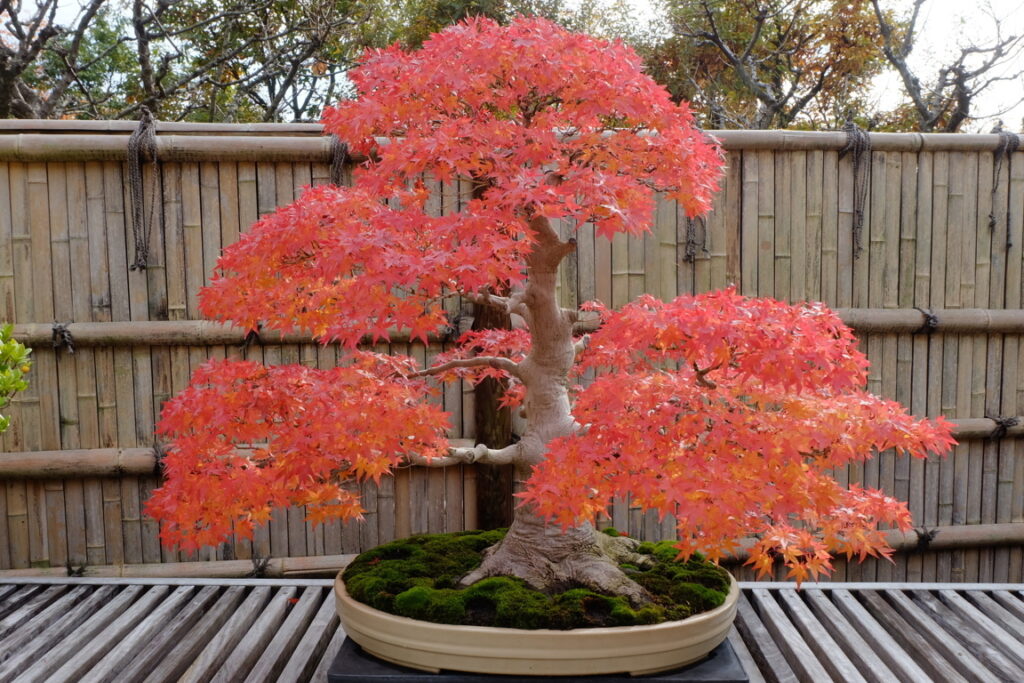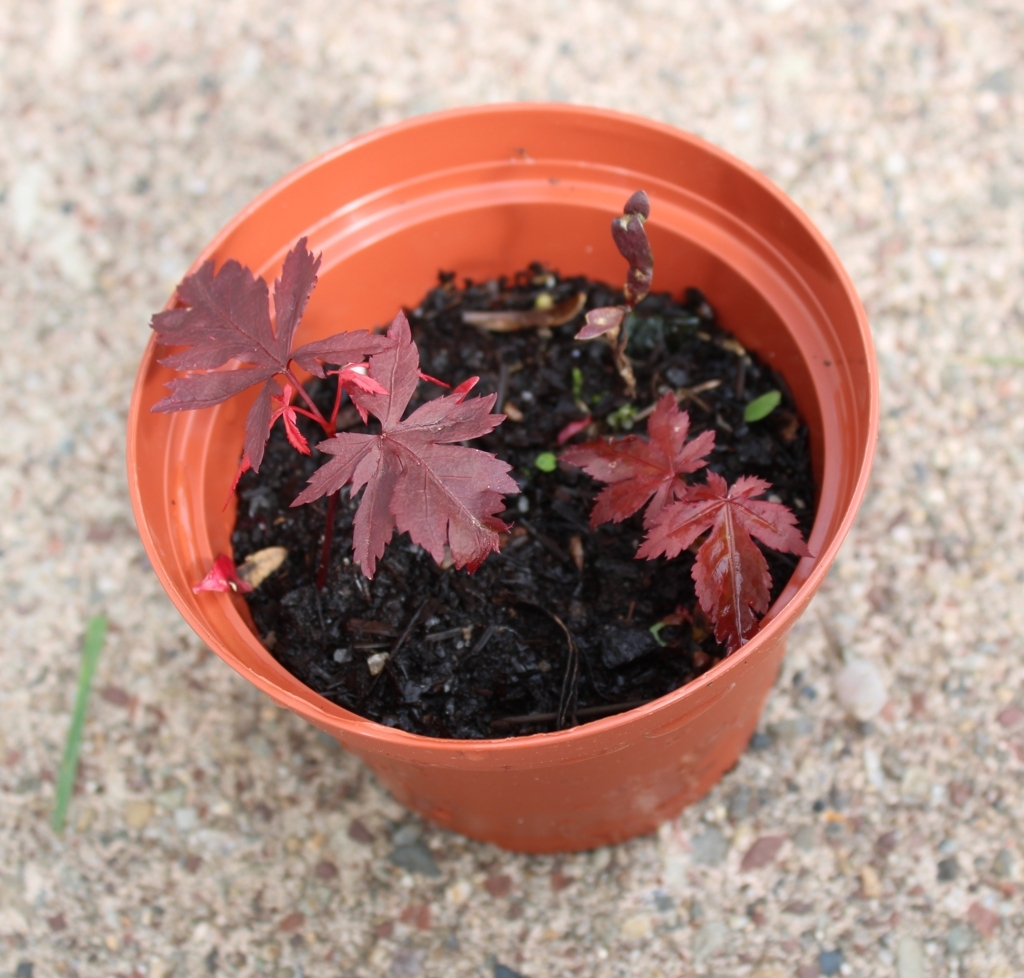With their stunning leaves, Japanese red maples are one of the most beautiful tree species you can cultivate for bonsai. Many different species of maple are used for bonsai, but the Japanese red maple (Acer palmatum) stands out. They keep their red leaves throughout the year until autumn, making for an outstanding bonsai. Growing Japanese red maple bonsai from seed is quite an easy process, so how do you do it?

Propagation is an essential skill in bonsai. You can make new trees for free, giving you lots of material to work with and develop over the years. There are many different ways to propagate trees – such as from seed, cuttings, air-layering, and ground-layering.
In this article, we’ll discuss growing maple bonsai from seed and then how to take care of them, making sure they develop into a lovely bonsai tree.
Collecting the Seeds
If you’ve ever seen seeds floating down from the sky slowly, chances are that it was a samara. Maples produce samaras, which have little wings to help the seeds they carry to spread further..

Maples will produce these samaras in autumn, so it’s best to look for them then. Once you have found one, you should break off the wings of the samara and place the seeds into warm water for 24 hours.
Another option is to purchase seeds from a retailer. Bonsai nurseries or independent sellers typically sell maple seeds in large quantities for a low price, allowing you to try and germinate a lot for cheap. This will also save you the effort of collecting the seed yourself, especially if you don’t have any maple trees near you.
Stratification of Seeds
Once you have soaked your seeds, you need to give them a cold period known as stratification. This encourages them to germinate when you plant them, as they follow the natural cycle they would be exposed to in nature.
With maple seeds, you should store them in a fridge for around three months. I dampen some paper towel and wrap the seeds in it, placing a plastic bag over them with some holes poked in the top for ventilation.
Sowing the Seeds
After stratifying your seeds, you can now get ready to sow them! Prepare a mix of soil for your seeds. I use compost, perlite and sand. This holds a good amount of water but is also well-draining, preventing the seeds and seedlings from rotting/being overwatered.
With seeds, I like to use large trays to sow them in. It would be best if you spread the seeds apart from each other, giving them room to grow. Once this is done, sprinkle some of the soil mix over the seeds, ensuring they are covered.
After this, you can thoroughly water the soil mix with something such as a fine mist to ensure the seeds don’t move. Continue to water the seeds when the soil starts to dry out slightly, placing them in a shaded location that gets morning sun.
I recommend using a plant label to note down what you are growing and the date you sowed the seeds to ensure that you don’t get confused with any other seeds and can keep track of the time.
Transplanting Seedlings
When your seeds have successfully germinated, you can begin to water them more frequently. However, you should only be watering when they need it. You can poke your finger an inch deep into the soil to test the moisture of the soil, and if it’s soggy, you should hold off on watering until it starts to dry out slightly.
Seedlings can die a lot quicker than older trees from underwatering and overwatering, so always pay attention to the watering needs.
Another thing to watch out for is the seedlings needing more space. If you leave them in a tray for too long with other seedlings, their roots may get tangled, making it quite hard to separate them when you do. When you feel your seedlings are running out of space, delicately prick them out and transplant them into their own pots.
Try not to disturb the roots of seedlings. Otherwise, this can harm them as they don’t have many.

Growing Japanese Red Maple Bonsai from Seed
Seedlings will require a bit more care than older trees and can be pretty finicky at times; however, as they get older, they’ll be a lot easier to take care of.
Watering
Seedlings will have a lower water demand than older trees, so ensure you address this when watering them. They are easier to kill from overwatering and underwatering, so make sure to test the soil’s moisture before you do water.
In the growing season, your maple seedlings will likely require a lot more water than in autumn or winter, so ensure that they are always getting enough to drive growth in the seedling.
Fertilizing
As a personal preference, I’m not particularly eager to fertilize my seedlings for a while. The roots are small and sensitive, so I hold off on fertilizing for a few months. When I do apply fertilizer, I make sure to use quite a diluted concentration and increase it over time.
Fertilizer will help to drive seedling growth and promote the development of the roots, ultimately helping your seedling to develop into a bonsai much faster.
Repotting
When your seedlings have outgrown their tray, you should repot them into their own individual pots. This gives them a lot of room to push out their roots, and you usually won’t have to repot them again for a year or two.
If your seedlings have outgrown their individual pot, you should repot them into a larger pot. Unless you are trying to develop a shohin bonsai, I recommend using something other than bonsai pots to begin with.
Wiring
I don’t usually wire my seedlings in their first year, as they are still quite vulnerable and soft. Instead, I typically wait until the second year to start applying wire.
A benefit of growing Japanese red maple bonsai from seed is that you can get some good twists and turns in the trunk early, forming the tree’s structure when it’s older. If you wire it earlier, I recommend using a low gauge such as 1mm or 1.5mm.
Further Reading
If you want more information and detail on how to take care of your seedlings, you can refer to this article in which I discuss care more thoroughly for all species.
Growing and Caring for Bonsai From Seed
Frequently Asked Questions (FAQ)
How long does it take for my seedling to develop into a bonsai?
From seed, it can take around 15-20 years for them to develop into quite an excellent bonsai. This can be sped up by techniques such as planting them in the ground, which will develop the trunk a lot faster. However, you still need to develop the branches and ramification. Maples aren’t as slow-growing as other species, such as pines and junipers, so you might be able to fast-track the timescale by a few years. If this is still too long, you can usually buy quite thick trees from nurseries or buy an already-developed bonsai tree.
How long does it take for Japanese red maple seeds to germinate?
If you have exposed the maple seeds to a cold period, they should take a few weeks or longer. Not all of your seeds may germinate; some may even wait a year or two before germinating. If you have not stratified the seeds, this process may take longer, and the success rate may be pretty low.
Are Japanese red maples hard to grow from seed?
Compared to other methods, such as growing from cuttings, growing Japanese red maples from seed is much easier. Getting maples to strike from cuttings can be challenging, so many growers tend to use air-layering or seeds. Seedlings may not stay true to the variety of the mother tree, though, so the new maple might not be as impressive.



